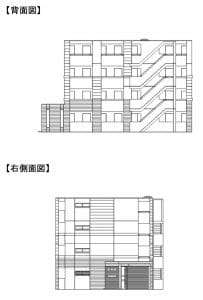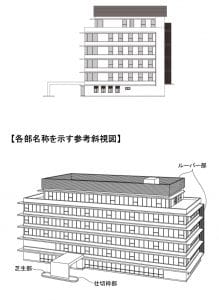This time, we take a look more at Building Designs so that you can file to protect your images, and be aware of possible infringement risks, in Japan.
It seems that countries’ approaches to protecting intellectual property for an architectural work, i.e. a building, vary. Copyright and trademark rights seems to be the popular options for in the United States.[1] In Japan, however, a more general Design patent of buildings (or even bridge structures) can be useful since April 2020, and indeed registrations are making some building designs clearly protected. These are being made for not only iconic single buildings but for other structures, as well!
You may need to conduct searches to avoid infringement when working on architecture there, or you may have a design worth protecting.
Why Would a Common Building’s Exterior Be Protected as a Design in Japan?
This is conjecture, but since the “baby boom” after World War II and the intense urbanization (particularly with a draw to the Tokyo megalopolis area), builders have constructed countless small or medium-sized suburban houses, apartments, and condominium structures with little individual distinction. Major builders have developed “product lines” of condominiums, for example, that go up around the country and are familiar to home purchasers as signs of quality or reliability. Even siding is relatively similar around neighborhoods, compared with, say, much of American suburban housing.
So it does make sense for the Japanese, who favor stability, to treat a popular building exterior design as intellectual property.
What Might be Registered as a Building Design in Japan?
The JPO gives a sampling of registered Designs for buildings, including these.[2]
House exterior |
Condominium exterior |
Office building exterior |
 |
 |
 |
Cafe exterior (CG sample) |
Shopping facility exterior (CG sample) |
Store exterior (CG sample) |
 |
 |
 |
Any Warnings?
You may want to take steps to protect a building’s exterior design, if you think it will appeal to a broad group in Japan’s urban or suburban building and business trends. On the other hand, a thorough search by Japanese IP professionals will help make sure you do not unwittingly infringe on a building design of someone else.
* The information provided on this website is for informational purposes only and is not intended as legal advice.
** For questions or consultation, please contact us for more information.
Taro Yaguchi
Sources
[1] Recent resources are scarce, but see, for example, (a) Anuja Shah, “The protection of architectural design of buildings – a growing trend,” https://www.lexology.com/library/detail.aspx?g=e56cbff7-a884-4935-af05-5084f90bd5ad January 6, 2018, accessed March 31, 2022;
(b) Gordon Rees Scully Mansukhani, LLP, “Protecting the Intellectual Property of Architectural Works: The Fundamentals of Copyright and Trademark Protection,” https://www.grsm.com/publications/2015/protecting-the-intellectual-property-of-architectural-works-the-fundamentals-of-copyright-and-trademark-protection May 2015, accessed March 31, 2022.
[2] Japan Patent Office. “建築物の意匠登録事例集 [Samples of structure designs].” https://www.jpo.go.jp/system/laws/rule/guideline/design/document/kaisei_hogo/kenchiku.pdf Updated March 9, 2022. Accessed March 31, 2022. Found on Japan Patent Office, “改正意匠法に基づく新たな保護対象(画像・建築物・内装)の意匠登録事例について [Examples of new registered designs (graphic images, buildings, interiors) under the revised Design Act],” January 4, 2022, updated March 9, 2022, accessed March 31, 2022.
Header image by David Mark from Pixabay






